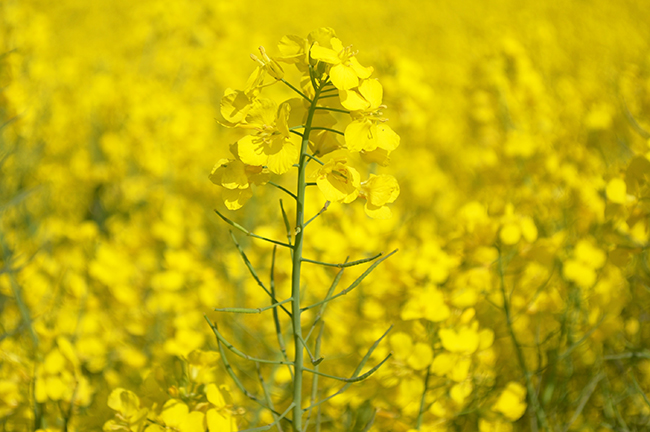Erucic acid contamination of double low oilseed rape varieties
20th March 2019
Over the last three years, higher than expected levels of erucic acid have been found in oilseed rape seed which has been grown from double-low varieties.
Over the last three years, higher than expected levels of erucic acid have been found in oilseed rape seed which has been grown from double-low varieties. This has resulted in growers incurring penalties on consignments, or having consignments rejected.
With the announcement by the European Standing Committee on Plants, Animals Food and Feed on February 8 this year that the legal limit for erucic acid (EA) in rapeseed oil is to be reduced from the current 5% to 2%, there is real concern that the number of loads rejected due to EA contamination will increase.
A recently concluded NIAB project, funded by the AHDB (PR602), which looked into where the high EA contamination was coming from, identified the main source to be oilseed rape volunteers.
Mr Simon Kightley, who led the project, said, “We have come to the conclusion that the problem is coming from OSR volunteers that have lain in soil, for a long time in some cases, not necessarily dormant but regenerating every time that OSR comes back into that field. The volunteer seed germinates, if the field is cultivated to the right depth, when the new crop is planted. These volunteers are virtually indistinguishable from the sown crop and will grow and set seed which is harvested with the crop. Volunteers also cross pollinate with the farmed crop. This happens all the time in rape crops but if the volunteers are high EA then the seed they produce will be high EA and a proportion of seed in the farm crop will become high EA which will have an immediate impact on EA levels.”
Seed rates today are much lower than they were historically, with growers now targeting populations as low as 40 plants/m2. Mr Kightley added, “These populations are fine but it does mean that when volunteers emerge in the field they become a significant part of the crop.
Put very simply one fully high erucic acid seed at 50% erucic acid, in 50 seeds at harvest can raise the level in the sample by 1% , and broadly speaking, one high erucic plant per square metre will do the same.”
Mr Kightley said, “Volunteers can be minimised by three main approaches:
- direct drilling to minimise soil disturbance
- creating stale seedbeds and the removal of volunteers before the crop is drilled
- growing Clearfield and spraying off the volunteers once the crop is established.”
It is imperative that growers control their volunteers, especially if they know there is a background of high erucic oilseed rape (HEAR) cropping, and they control the charlock. Mr Kightley said, “I don’t think for a moment that it is just volunteers causing this problem, there is always the threat of poorly controlled Brassica weeds like charlock, which has 42% EA. You don’t need many seeds in a hundred to suddenly start pushing up to the limit. Clearfield varieties and the chemistry used with them are the ideal solution to both parts of this problem.”
Sarah Middleton, BASF Campaign Manager for Oilseed Rape, added, “Clearfield(R) is the only weed control system that controls volunteers within the oilseed rape crop. Growers with serious problems with EA volunteers should be looking to the Clearfield system to give them the confidence to continue to grow rape in those fields, knowing that volunteers will be sprayed out in the autumn.
When growing Clearfield hybrids, the field must be be treated with the correct herbicide, either Cleranda(R), (imazamox & metazachlor) or Cleravo(R) (imazamox & quinmerac) to gain the full benefit of weed and volunteer control.”
She added, “Knowing the history of fields where OSR is the planned crop helps to identify areas which could be EA hotspots; if HEAR was previously grown then this knowledge can inform the choice of variety and the husbandry of the crop.”
Most double low (00) varieties have levels of EA less than 0.1%, which are virtually undetectable, and the project found crops grown from hybrid seed, and from Clearfield varieties in particular, had the lowest EA values.
Mr Kightley said, “Many growers use farm saved seed (FSS) successfully but the really big problem does come when growers save their own seed with no real knowledge of the problems they might be generating. If you have land where a good proportion of the volunteers are high EA then it is just plain wrong to save the seed from that field. FSS will undoubtedly make problems worse and help to spread that problem around the farm.”
If growers do use FSS, Mr Kightley said, “Get it tested and confirmed at 1% EA or less. NIAB and other labs do test to determine the EA level of seed. I would suggest that they need to ask for a gas chromatography (GC) test, as this is the most accurate test available.”
Mr Kightley concluded, “Growers should retain samples of the oilseed rape at each step in the growing, harvesting and marketing process, in order to be able to send a sample to be independently tested should the need arise.”

